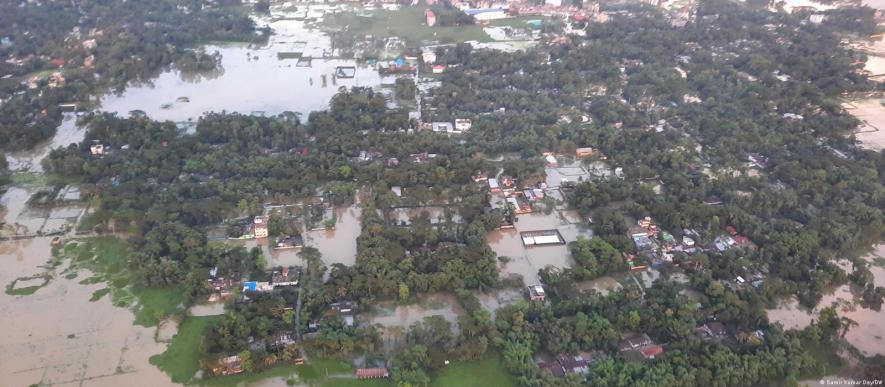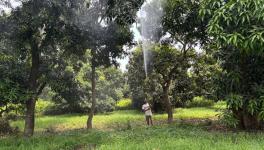South Asia Desperate for Positives From COP27

South Asia is very much on the frontlines when it comes to climate change and COP27 — the UN's annual conference dedicated to the environmental crisis — is taking place at a critical juncture as the region deals with increasingly frequent and intense weather events.
By the end of the current decade, South Asian nations will incur costs of about $160 billion (€163 billion) per year because of climate change, according to the World Bank. The financial institution also estimates that in the next three decades the region will experience at least 40 million climate migrants.
A 2021 study by environmental group German Watch focusing on the first two decades of the century revealed that 3 of the 10 countries in the long-term climate risk index are from South Asia — namely Bangladesh, Pakistan and Nepal. India and Afghanistan fall in the next 10.
The impact is worsening in India, which in 2021 alone suffered 19 climate shocks, while Asia suffered 174 in total.
Catastrophic deluges in Pakistan this year have affected some 33 million people, while massive floods displaced and destroyed the livelihoods of hundreds of thousands of people in Bangladesh and India's northeast.
"Floods were devastating in Pakistan, and I think an estimated $16 billion are needed for the reconstruction," Thomas Michael Kerr, lead climate specialist South Asia at the World Bank Group, told DW. "I would like to contrast it to the terrible Hurricane Ian. Florida also had a devastating impact, but you don't see the impact of that magnitude on the people versus people in Pakistan."
The 'new climate normal'
South Asians are living under intensifying heat waves, cyclones, droughts and floods. The scale and frequency of these events are testing the limits of governments, businesses, and citizens to adapt to the new normal.
The World Bank says that the changing climate could sharply diminish living conditions for up to 800 million people in a region that already has some of the world's poorest and most vulnerable populations.
"It is gutting. It upsets me deeply. Floods submerged much of the country and millions of people had nowhere to go," Aliza Ayaz, a young Pakistani climate activist and United Nations Goodwill Ambassador, told DW. "I wish I could do more. I wish I could be on the ground. Such devastating times for people are the only times I wish I was in the highest place of position and influence, so I could dispose of help and money to emergency causes to save lives and rehabilitate homes."
Like Ayaz, climate activists and experts are eyeing this year's UN climate conference, COP27, to find more sustainable solutions for the affected people. There is particular concern surrounding the pledges from the the 2015 Paris Agreement.
"There was a dilution of climate justice in the Paris Agreement itself through the expectation that the emissions reduction burden must be borne equally by all countries, rich or poor," Avantika Goswami, a policy researcher from the India-based Center for Science and Environment, told DW.
"This inequity will worsen as poor and vulnerable countries suffer disproportionately from a crisis that they have not caused and are also not receiving adequate financial compensation to recover and rebuild," she added.
Financing climate resilience
The global climate finance target, set at COP15 by developed nations, is supposed to be $100 billion a year from 2020 onward. So far, the pledge has not been fully met. The British international NGO Oxfam estimates $21-$24.5 billion as the "true value" of climate finance provided in 2020, against a reported figure of $68.3 billion in public finance that developed countries said was provided — alongside mobilized private finance bringing the total to $83.3 billion.
COP27 will focus on scaling-up adaptation solutions while mobilizing and strengthening access to financing for adaptation.
"Money that goes for mitigation, generally goes for renewable projects, like solar or wind energy projects," Saleemul Huq, director of the Dhaka-based climate education institute ICCCAD, told DW. "Those energy projects generate an income. So, these projects can be funded with loans. That is why the developed countries are more interested in mitigation projects. On the other hand, adaptation money should be given as grants, because it will help a flood-affected destitute person in Bangladesh or Pakistan."
Policy researcher Goswami believes the COP15 goal of $100 billion per year was "an arbitrary figure that grossly underestimated the needs of the developing world for mitigation and adaptation."
"Discussions at COP27 must advance towards a new figure for climate finance from 2025 onward that accurately captures these needs," she continued. "Developed countries must also answer for the gap in finance so far, and how the current goal will be met till 2025."
Kerr from the World Bank also said that because of revenue generation opportunities, the private sector is more interested in mitigation projects.
"We have to come up with new ways to finance climate resilience across South Asia," Kerr said.
With an eye on COP27, Kerr hopes "we can bring people together to think about what else we can do to bring more finance for resilience in these countries."
Loss and damage
In recent years, more vulnerable countries have been talking about creating another fund called Loss and Damage. They say that countries at risk are suffering huge losses from natural disasters caused by man-made climate change.
Beyond adaptation or mitigation, rehabilitation of affected people also requires large sums of money.
"The floods in Pakistan were 50% more severe because of human-induced climate change," Huq from ICCCAD said. "This is a new demand to the rich countries to provide additional funds from mitigation and adaptation to help the victims who are suffering from loss and damage now. Adaptation and mitigation have failed for them. They are suffering. They need help now, and for that we need a fund."
Loss and Damage is not yet a standing agenda item in the COP27. It is a provisional agenda. At the beginning of the upcoming conference — which will be held for two weeks from November 6 — it has to be adopted by all the parties. The pressure and expectations for that from the climate vulnerable and developing countries have mounted.
"Even one country can object and stop it from being adopted. If that happens that will be a big fight, and the COP will be declared a failure even before it has started," Huq, who is also the chair of the experts of climate vulnerable forum, said.
"We now have evidence that extreme events are happening because of human-induced climate change," he added. "The IPCC sixth amendment report has clearly mentioned that it is attributable to the carbon emissions because of human actions. COP27 is the first COP in this new era, and it has to deal with this problem."
Edited by: John Silk
Get the latest reports & analysis with people's perspective on Protests, movements & deep analytical videos, discussions of the current affairs in your Telegram app. Subscribe to NewsClick's Telegram channel & get Real-Time updates on stories, as they get published on our website.
























